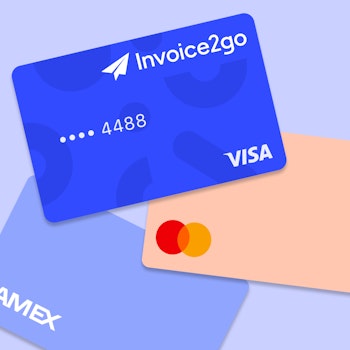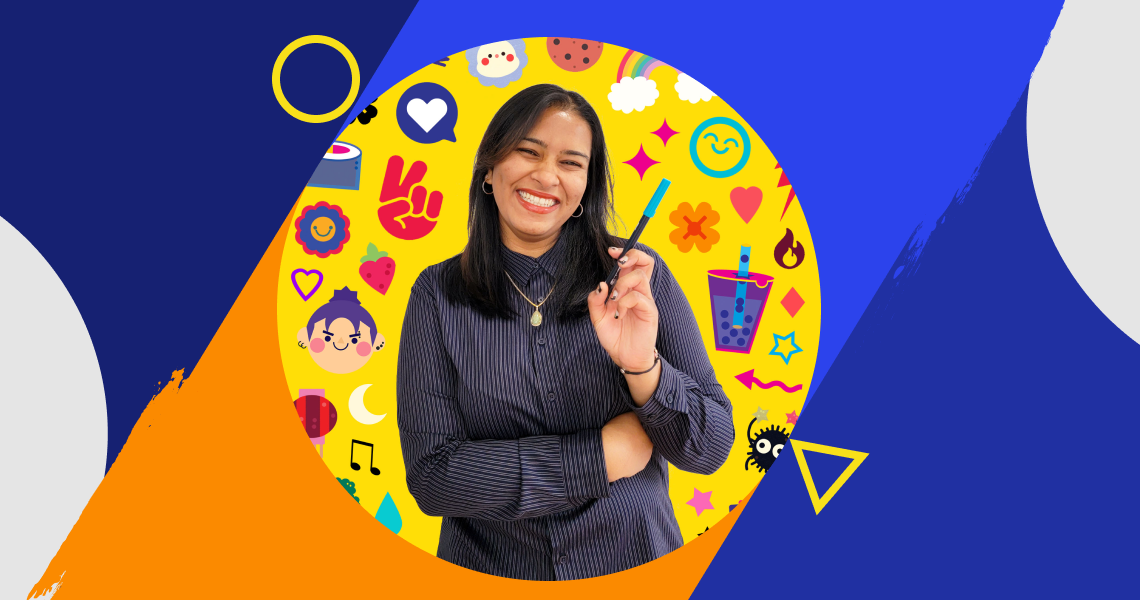
Invoice2go Artists: Q&A with Ameena Fareeda
Despite the tragedy of the pandemic, there have been a few glimmers of possibility. For many creatives, COVID catalyzed the transformation of their passion into profit.
Among them was Ameena Fareeda, who’d worked as a childcare teacher for six years before the pandemic hit. Amid the tumultuous economic climate, the Maryland Institute College of Art grad stuck with her 9-to-5 but started a side gig as an illustrator and designer, devoting nights, weekends, and any free time in between to working on client projects and crystallizing her brand.
Ameena’s hustle paid off. Now, she’s a full-time freelance illustrator and designer who’s landed clients among the likes of Warner Bros. Discovery and YES! Magazine. But career success aside, she wants her work – which often depicts everyday objects found in many AAPI households – to be a voice for her community. During a spate of violence spurred by anti-Asian COVID rhetoric, her vibrant, shape-based art celebrates Asian identity and joy.
Fellow Asian Americans have thanked her, remarking that her pieces make them feel at home. The gratitude is mutual. “I’m very thankful I’m getting so much love for my work,” she says. “It’s something I didn’t think twice of making, like, I’m going to make this because it’s just who I am.” That steadfast commitment to creating the art she wants to create is her superpower, allowing her to set herself apart as a go-to illustrator and designer for anything AAPI-related. In fact, we tapped Ameena to illustrate our recent post spotlighting AAPI small business owners.
In a Zoom conversation with us from her brightly-lit home in Silver Spring, Maryland, Ameena further illuminated how being unapologetically herself, even if initially met with resistance from her family, helped catapult her career. She also emphasized the importance of avoiding the comparison trap and reverse engineering others’ success to create your own.
What inspired your love for illustration and design?
Growing up, I drew anything and everything I could. I was always asking for crayons, markers, stickers, and any sort of stationery or colorful thing I could get my hands on. I will say that being part of the Asian community, my parents weren’t very keen on the idea of me being an artist. But they encouraged that creative side of me, letting me take art classes and doing whatever I could to get a sketchbook. My oldest brother is also a designer, and both sides of my family have creatives. I think it was a common thread my parents couldn’t help but embrace in the end.
I was the first in my family to attend a private art school, so it was a big deal. It was like, “Ok, if you do it, you’ve got to stick to it.” Thankfully, it was the right decision for me. So the pressure was there, but I also had a supportive family who could tell, “This is her thing.”
Your style is so bright and exuberant. Who and/or what are your artistic influences?
I’ve always been drawn to super colorful, vibrant things. I think that’s just part of my culture and who I am as a person. The Asian diaspora has such a colorful, vibrant, bright culture. Especially being Indian, too, I’m constantly surrounded by colorful clothing, food, and jewelry.
I think one of my main inspirations was learning screen printing and printmaking. Feeling the way this flat aesthetic was just so clean and bright – it scratched my head really nicely. It was colorful and clean, and it combined illustration and design perfectly for me.
Also, before I transitioned to freelancing, I was working as a childcare teacher for six years. To children, everything is amazing. The way I translate my shapes and language is inspired by them: unapologetically themselves but also simple and fun.
I love how you amplify Asian American culture through everyday objects. Where did that approach come from?
If I wasn’t going to pursue the arts, I was going to pursue Asian American Studies. That stemmed from learning more and more about who I am as a person and who I am as an Asian American growing up in Maryland. I’m proud of the complexities Asian Americans hold. Our community is so rich and diverse in experiences that it’s worth telling a story about.
I grew up with other Asian Americans and first-generation friends, so amplifying the voices of our community just felt so natural. I want it to feel like seeing our world through a child’s eyes. My friends and I experienced so much pressure being Asian American growing up, but there's a bright side to it. The cute, kitschy things I draw are so relatable because they’re part of our childhood, things that bring us joy. It’s not all trauma and sadness that we have to endure.
Why is it important for you to “create work that enhances voices of the Asian American community,” as your website bio says, especially now?
When I was little, I faced a lot of discrimination because of 9/11. Also, being this little Indian girl in school, usually surrounded by no other Indians, was really isolating. I had that feeling of, “I want a community.”
I think it’s important to remember how similar us Asian Americans actually are. When I heard about the unfortunate events that took place during the pandemic with all the Asian hate, I made one singular piece that said “Stop Asian Hate. We are not your model minority.” That was received really well, and it was shared on multiple media platforms.
I was so thankful because it brought to light that people like me can relate to what's going on. It seemed like South Asians weren’t allowed to say anything because the violence was targeting East [and Southeast] Asians. But I have close East Asian friends. I feel for them. And I already had to deal with that when I was little. I imagined them going through that multiple times. It’s happened throughout our lives, throughout generations. I couldn't help but be like, “This is really the time for enhancing our voices as a community – every part of our community.”
How did you make the leap from your 9-to-5 to freelancing?
I’m literally one-and-a half months into freelancing. Quitting my full-time job as a childcare teacher felt like a relief, and I was also just ready for the next chapter of my life.
When I was forced to stay home during the pandemic, I was constantly making work, and I developed my voice and aesthetic. I noticed that people responded really well to my work. For example, I randomly applied to work with the National Cherry Blossom Festival here in DC. I stayed up late, but it paid off. I created a giant cherry blossom sculpture painting. It sits in Franklin Park now, but at the time, it was sitting at the Smithsonian. I was like, “Something’s working here.”
I kept it going, but because of the pandemic, a lot of people were firing rather than hiring. It didn't feel like the right time. So I’d do client work after my full-time job in the evenings, on weekends, and any available time in between. I’d take meetings during my break at work. But as a result, I had so many connections and just felt comfortable moving on to the next step. As cheesy as it sounds, it just felt something inside me was like, “Nah, you’re ready. Give it a shot.”
What lessons have you learned along the way?
Give yourself time. If the timing is right, everything will fall into place. I have a lot of friends who had it easier. I didn't land any big client names for an internship or full-time position in the arts. Unlike my friends, I went directly into a 9-5 safety job. It was hard for me not to take it personally. Now I know there’s no shame in having a job unrelated to your field. It's also important to note I didn't have the luxury to not work, either. The pandemic hit me hard – I was furloughed from my safety job. But I used it as an opportunity to build my portfolio.
A lot of my friends were also encouraged to dedicate themselves to the arts from the beginning. But coming from an Asian immigrant family, being an artist isn't considered favorable, generally speaking. I had to do more work to prove it would be worth all the passion I poured into it. There were times when people tried to sway me toward pursuing something more reliable. But I continued to work on my craft, and I’m glad to have my support system alongside me now.
When people start out freelancing, they tend to take whatever work they can get. How did you narrow your focus?
I decided I was going to make what I wanted for who I wanted, and that was going to attract the people I wanted to work with. I think my first dose of that was in high school when I did have a focus on Asian American identity, which I carried into college. I had this gut feeling of, “I don’t care whether you get sick of me drawing ramen every day. It’s part of who I am.”
And whether it was paid or personal work, I’d share it on Instagram. If people liked it, they liked it. If they didn’t, it was fine. Now, many come to me strictly for AAPI-themed content.
What advice would you give artists considering going the freelance route?
If you want to become a freelancer, go for it, but also keep in mind that you need to make sure you’re ready in all aspects, not only mentally and personally, but also financially and creatively. I didn’t go all in until I had a clear voice, clear aesthetic, clear branding, clear marketing. The harsh truth is that the creative world is very competitive. There are many other artistic voices who are dreaming big and trying to "make it.” Showing who you uniquely are is going to be what works in your favor.
When I figured that out, I had to make sure everything looked good together. I researched the websites and blogs of artists who inspired me and were established in their fields. They were professional but still fun, and you could still see the artist in them. Likewise, I have a more personal approach where everything is readable but very much fun. I wanted it to still speak to my work. I also reached out to artists with questions like, “What website did you use? What platform did you use?” There’s nothing wrong with asking for help.
I spend hours on social media studying artists’ audiences and clientele, and whether they’d reflect or benefit me. One of my colleagues who I’m friends with now, Dingding Hu, is everywhere, but it’s because she’s unapologetically herself. She loves drawing food, so people who need food illustrations go to her. Her style is fun and quirky, and that’s what they want. It’s finding those things that work for you and working backwards. If you noticed this artist worked with this client – ask yourself, why? What did they make? What are their interests?
What do you hope your work ultimately accomplishes?
I hope it brings the childlike joy we all had of being with our cousins and our family, eating all the dim sum and rice we want. I don’t expect to be in galleries or anything, but I want my work to be so out there that you just can’t ignore it. I feel like our community’s been ignored in multiple ways. I hope my work can be that voice that says, “You’re not going to ignore us anymore. Here’s all of the stuff that represents who we are.”
Related Articles
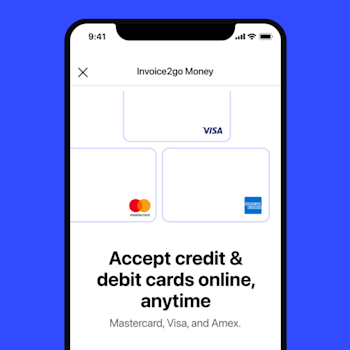
How to accept credit card payments on Invoice2go in 3 simple steps
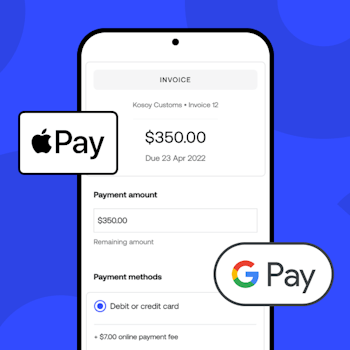
Accept payments online via Apple Pay and Google Pay

Must-not-miss write-offs as you wrap up 2022 year-end finances
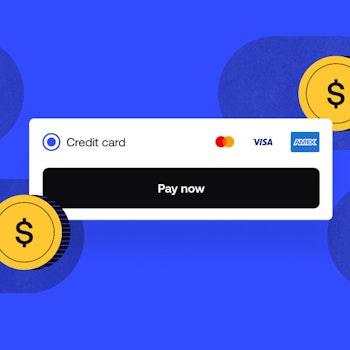
5 ways accepting credit and debit card payments helps your business stay resilient

4 easy ways to increase cash flow today

What is Small Business Saturday and why is it important?
The features and surprising benefits of a well-designed packing slip
